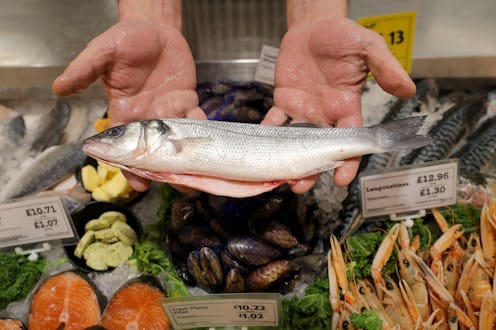
Well, I’ve got good news if you like seafood and bad news if you’re scared of mercury poisoning: The FDA announced on Tuesday that it’s currently drafting new federal guidelines for seafood consumption, and the updated recommendations say that pregnant women, young mothers, and children in particular should be eating way more fish than they probably are. The previous guidelines, set in place in 2004, may have left some women under the impression that they should stay away from any and all seafood while pregnant or breastfeeding because of that whole pesky mercury issue — but the government is now saying that most of the seafood consumed in the U.S. doesn’t have enough mercury in it to actually be a problem.
That problem, if you’re not familiar with it, is that mercury can cause heart damage and prevent healthy brain development if it’s consumed in high quantities; however, it looks like fear of mercury may have been robbing us of the rest of the benefits to be gained from eating seafood in the first place. “For years many women have limited or avoided eating fish during pregnancy or feeding fish to their young children, said Stephen Ostroff, Acting Chief Scientist of the FDA. “But emerging science now tells us that limiting or avoiding fish during pregnancy and early childhood can mean missing out on important nutrients that can have a positive impact on growth and development as well as on general health.” As such, the guidelines, which you can see in their entirety here, recommend that that pregnant women, moms, and kids eat between eight and twelve ounces of a variety of low-mercury fish a week. Fish to avoid due to high mercury content include tilefish from the Gulf of Mexico, shark, swordfish, and king mackerel; additionally, albacore tuna should be limited to six ounces a week. Fishes that are A-OK to eat include salmon, shrimp, pollock, tilapia, catfish, and cod.
According to the Chicago Tribune, critics of the new guidelines say that the government is offering them without telling us which fish have the most health benefits and which ones are the worst offenders in terms of mercury; I’m not totally sure how that’s the case, though, as the guidelines themselves include a big ol’ chart detailing both. Maybe they haven’t had a chance to read the draft yet? I don’t know. If anyone can explain it to me, I’m all ears.
I’ll be honest: I love seafood, so much so that I’ve generally ignored all the warnings about how much mercury might be in my favorite finny delicacies. This is probably not the smartest thing I could be doing, and if I die at an early age due to mercury poisoning, I give everyone full rights to chant “I told you so!” over my cold, dead body. If, however, I was actually following the new guidelines before they even existed, then I will consider myself ahead of the curve and will hopefully reap the health benefits sooner and more efficiently. Also, more sushi for me. Hoorah!
If you’re now convinced that you should be adding more seafood into your weekly menu plans, but aren’t sure where to start, allow me to offer two recipes: Poor Girl Eats Well’s Spicy Red Quinoa and Shrimp, and Cooking Classy’s Balsamic Glazed Salmon. They’re delicious, easy, and pretty wallet-friendly as far as fish dishes go. Pro tip: If you don’t live in a place where you can get fresh, affordable seafood, those big bags of frozen salmon fillets and cooked, tail-off shrimp you can get at Costco are amazing. Just thaw out what you need and you’re ready to go. Happy eating!